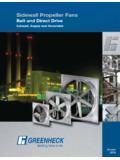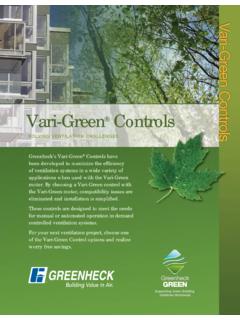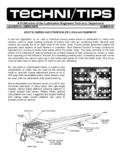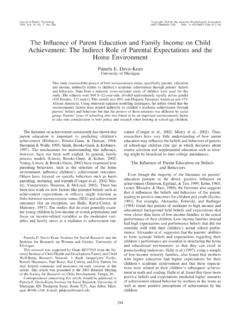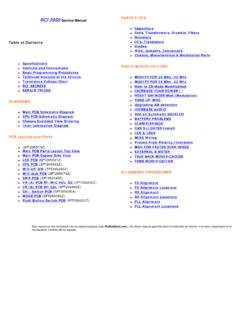Transcription of Correcting water level data for barometric pressure ...
1 - - 126 - dicembre 201123 ScienzaAbstractThe main concepts for identifying and removing ba-rometric pressure effects in confined and unconfined aquifers are described. Although is commonly known that barometric pressure changes can effect water level readings, few articles and procedures are provided to correctly manage piezometric the barometric efficiency reduces errors in calculating piezometric surfaces and drawdowns in the piezometers during pumping tests. Stallman (1967) suggested furthermore, that air movement through the unsaturated zone and the attendant pressure lag, could help to better describe the aquifer properties. Rasmus-sen and Crawford (1997) described how barometric efficiency varyes with time in some aquifers and how to calculate the corresponding barometric response fun-ction (BRF).
2 They also showed that this last parameter is related to the degree of aquifer confinement. Finally we present an application of the procedure in an uncon-fined karst aquifer located in northern Namibia (Otavi mountainland) where a set of four absolute transducers have recorded water level changes and earth tides during a 10 months period at 1 hr of water levels in wells opened to the at-mosphere and due to barometric pressure changes were noted first by Blaise Pascal (1663). Since 40 s, various Authors tried to better describe this phenomenon and to separate the variations due to water level changes, the recharge, from those only barometric . Among these reports, those of Jacobs, Weeks, Rasmussen, Crawford, Clark, Bredehoeft etc.
3 Are the most important. An in-teresting result of this approach deals with the validity of the interpretation of piezometric maps. When con-sidering water level changes and atmospheric pressure , some aquifers show an inverse reletionship: increase in barometric pressure creates declines in observed water le-vels and vice versa. Two important consequences are pie-zometric map interpretation over large areas and/or with low gradient and pump test analysis. For example, when dealing with pumping tests and piezometers we have to correctly remove barometric pressure influences to cal-culate trasmissivity values. The long duration test should induce drawdowns in the order of 20-30 cm in the pie-zometer.
4 To achieve this, the pump discharge should be high and/or the borehole closer to the producing well. Moreover, it is widely recognised that the attraction of Moon and the Sun can influence piezometric levels and give useful hints for a correct interpretation of aquifer parameters. We refer to sea and earth tides and the cor-responding calculation of the tidal components and har-monic functions. Before describing in more detail this topics, let s revise some important concepts like the ba-rometric efficiency (BE) and the water level transmission trough the unsaturated soil and well casingTo dress up a piezometric map, one normally records the water level in the wells using a water level dipper.
5 The piezometric head is:(1) H = W + BW = elevation of water column above datumB = barometric headLack of atmospheric records can be avoided using an average value over a long in the everyday practice, barometric pressure is not considered and the piezometric head corresponds Correcting water level data for barometric pressure fluctuationsTheoretical approach and a case history for an unconfined karst aquifer (Otavi, Namibia)Alessio Fileccia** Hydrogeologist, self employed consultant, Treviso - 126 - dicembre 201124 Scienzato the height of the water column above datum. Fur-thermore the well response varies due to casing, well completion and aquifer borehole responds with a time lag to the external pressure due to: Well storage Thickness of the mud cake on the walls Length and type of screensThe last issues are known as skin effects.
6 The lag time can be as much as hours or days. Thick mud cakes and short screen lengths slow down the rea-ching of equilibrium between the water levels on either side of the well. It is something similar to the pumping of a bike inner tube: we force the air through the valve (well screen) using a hand pump (external atmosphere) into the rubber inner tube (the borehole) can consider two cases:Phreatic aquiferIf the static water level is near to surface and/or the un-saturated layer above the water table is thin, the pressure variation moves fast and the well has a quick response. The water levels do not Special well completion techniques reduce the impact of pressu-re variation with an isolation of the casing from the atmosphere (isobaric wells)A particular case is reported during severe storms.
7 When rainfall is high the decreasing barometric pressure over-laps the water infiltrating vertically through the unsa-turated part, trapping and pushing the air towards the water table and the screens into the well. This behaviour can induce quick variations, higher than the barome-tric2. At he equilibrium the atmospheric pressure (pa) is the same in every point of the aquifer (pw) and in the well (fig. 2). The water percolating downwards induces a rise in the air pressure trapped above the water table (dpa) increasing also the pressure on the water by an equivalent amount (dpw).2 The equilibrium at the well is given by:(2) pa + H = pw + dpwsince pa = pw and dpa = dpw, we have(3) H = dpa2 This beahviour has been reported for the blowing wells of the Friuli plain by A.
8 Feruglio, and the sudden rise of piezometric levesl in the boreholes during Piave river floods by R. water level changes in unconfined aquifer due to barometric pressure variations (thin unsaturated soil with high permeability)2. water level fluctuations due to air entrapment during groundwater recharge in an unconfined aquifer (A. Freeze, J. Cherry 1979, redrawn) - - 126 - dicembre 201125 Scienzasubstituting:(6) dpw = dpa + ( h h) and (7) dpw dpa = ( h h)being(8) dpa = dpw + ds where ds is the effective stress on the grainsthen dpa > dpw and h < hThe relationship is an inverse one, increases in in ba-rometric pressure create declines of water levels in the wells. It is important to stress that for such aquifers the-re is a time lag between the drop in the water level in the well and his new equilibrium with the aquifer (time lagged response).
9 This lag is in the order of a few hours or days and higher in case of thick and rigid aquitards or unsaturated efficiencyJacob (1940) was the first who attempted to introdu-ce a parameter describing this particular phenomenon known as barometric efficiency (BE).Considering a confined bed, the relationship is an in-verse one: a raise in barometric pressure induces a lowe-ring in the piezometric efficiency for the same time interval vari-dpa = atmospheric pressure variation; dpw = water pres-sure variation (at the aquifer top)when dpa > 0 also H >0 proving that an increase in the entrapped air leads to a rise in the water column inside the well (if opened to the atmosphere).This particular type of piezometric rise bears no rela-tion to groundwater recharge, but can be mistaken for it when associated to rainfall events.
10 In this case the in-duced pressure change generates well- water level that do not represent actual groundwater potential. Semiconfine/confined aquiferFor this aquifer the transmission of atmospheric pres-sure is instantaneous both to well and aquifer, being functions of the degree of confinement, matrix rigidity and specific weight of pressure at the aquifer top is supported partly from the rock skeleton and partly from the water thus in-troducing a time lag for the equilibrium to be reached (hours or days).On the contrary, the level in the well is reached without lag. If at the equilibrium we have: (see also equation 1 and fig. 4)(4) pw = pa + hwhen external pressure increases or decreases (dpa) then: (5) pw + dpw = pa + dpa + h 3.

